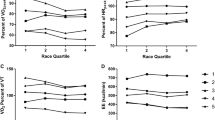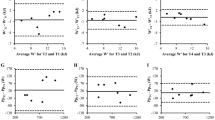Abstract
The purpose of this study was (1) to examine the value of a verification phase (VER) in a peak testing protocol and (2) to assess the reliability of peak physiological variables in wheelchair athletes. On two separate days, eight tetraplegic (TETRA), eight paraplegic (PARA) and eight non-spinal cord-injured (NON-SCI) athletes performed treadmill ergometry, consisting of a graded exercise test to exhaustion (GXT) followed by a VER. Peak oxygen uptake \( \left( {\dot{V}{\text{O}}_{{ 2 {\text{peak}}}} } \right) \) was compared (1) between GXT and VER and (2) between test days. \( \dot{V}{\text{O}}_{{2{\text{peak}}}} \) did not differ between GXT and VER (P = 0.27), and coefficients of variation between GXT and VER were in the range of 2.9 and 6.4 % for all subgroups. Coefficients of variation of \( \dot{V}{\text{O}}_{{2{\text{peak}}}} \) between test days were 9.3 % (TETRA), 4.5 % (PARA) and 3.3 % (NON-SCI). It is therefore concluded that whilst a VER can be used for a more robust determination of \( \dot{V}{\text{O}}_{{2{\text{peak}}}} \), a deviation of up to ~6 % between GXT and VER should be considered as acceptable. For between-day analyses, relatively large changes in \( \dot{V}{\text{O}}_{{2{\text{peak}}}} \) are required to confirm “true” differences, especially in TETRA athletes. This may be due to their lower aerobic capacity, which results in a larger relative variation compared with the other subgroups.



Similar content being viewed by others
References
Bar-Or O, Zwiren LD (1975) Maximal oxygen consumption test during arm exercise—reliability and validity. J Appl Physiol 38:424–426
Bassett DR Jr, Howley ET (2000) Limiting factors for maximum oxygen uptake and determinants of endurance performance. Med Sci Sports Exerc 32:70–84
Bhambhani YN, Eriksson P, Steadward RD (1991) Reliability of peak physiological responses during wheelchair ergometry in persons with spinal cord injury. Arch Phys Med Rehabil 72:559–562
Bhambhani YN, Holland LJ, Eriksson P, Steadward RD (1994) Physiological responses during wheelchair racing in quadriplegics and paraplegics. Paraplegia 32:253–260
Bland JM, Altman DG (1999) Measuring agreement in method comparison studies. Stat Methods Med Res 8:135–160
Borg GA (1982) Psychophysical bases of perceived exertion. Med Sci Sports Exerc 14:377–381
Campbell IG, Williams C, Lakomy HK (2004) Physiological and metabolic responses of wheelchair athletes in different racing classes to prolonged exercise. J Sports Sci 22:449–456
Day JR, Rossiter HB, Coats EM, Skasick A, Whipp BJ (2003) The maximally attainable VO2 during exercise in humans: the peak vs. maximum issue. J Appl Physiol 95:1901–1907
Devillard X, Rimaud D, Roche F, Calmels P (2007) Effects of training programs for spinal cord injury. Ann Readapt Med Phys 50:490–498
Goosey-Tolfrey VL, Tolfrey K (2008) The multi-stage fitness test as a predictor of endurance fitness in wheelchair athletes. J Sports Sci 26:511–517
Goosey-Tolfrey VL, Batterham AM, Tolfrey K (2003) Scaling behavior of VO2peak in trained wheelchair athletes. Med Sci Sports Exerc 35:2106–2111
Hopkins WG (2000) Measures of reliability in sports medicine and science. Sports Med 30:1–15
Howley ET, Bassett DR Jr, Welch HG (1995) Criteria for maximal oxygen uptake: review and commentary. Med Sci Sports Exerc 27:1292–1301
Katch VL, Sady SS, Freedson P (1982) Biological variability in maximum aerobic power. Med Sci Sports Exerc 14:21–25
Leicht C, Perret C (2008) Comparison of blood lactate elimination in individuals with paraplegia and able-bodied individuals during active recovery from exhaustive exercise. J Spinal Cord Med 31:60–64
Leicht CA, Bishop NC, Goosey-Tolfrey VL (2011) Submaximal exercise responses in tetraplegic, paraplegic and non spinal cord injured elite wheelchair athletes. Scand J Med Sci Sports (in press)***
Levine BD (2008) VO2max: what do we know, and what do we still need to know? J Physiol 586:25–34
Midgley AW, Carroll S (2009) Emergence of the verification phase procedure for confirming ‘true’ VO(2max). Scand J Med Sci Sports 19:313–322
Midgley AW, McNaughton LR, Carroll S (2006) Verification phase as a useful tool in the determination of the maximal oxygen uptake of distance runners. Appl Physiol Nutr Metab 31:541–548
Midgley AW, McNaughton LR, Carroll S (2007a) Reproducibility of time at or near VO2max during intermittent treadmill running. Int J Sports Med 28:40–47
Midgley AW, McNaughton LR, Polman R, Marchant D (2007b) Criteria for determination of maximal oxygen uptake: a brief critique and recommendations for future research. Sports Med 37:1019–1028
Midgley AW, Carroll S, Marchant D, McNaughton LR, Siegler J (2009) Evaluation of true maximal oxygen uptake based on a novel set of standardized criteria. Appl Physiol Nutr Metab 34:115–123
Poole DC, Wilkerson DP, Jones AM (2008) Validity of criteria for establishing maximal O2 uptake during ramp exercise tests. Eur J Appl Physiol 102:403–410
Price MJ, Campbell IG (1997) Determination of peak oxygen uptake during upper body exercise. Ergonomics 40:491–499
Rossiter HB, Kowalchuk JM, Whipp BJ (2006) A test to establish maximum O2 uptake despite no plateau in the O2 uptake response to ramp incremental exercise. J Appl Physiol 100:764–770
Scharhag-Rosenberger F, Carlsohn A, Cassel M, Mayer F, Scharhag J (2011) How to test maximal oxygen uptake: a study on timing and testing procedure of a supramaximal verification test. Appl Physiol Nutr Metab 36:153–160
Shephard RJ, Rankinen T, Bouchard C (2004) Test-retest errors and the apparent heterogeneity of training response. Eur J Appl Physiol 91:199–203
Smith PM, Amaral I, Doherty M, Price MJ, Jones AM (2006) The influence of ramp rate on VO2peak and “excess” VO2 during arm crank ergometry. Int J Sports Med 27:610–616
Valent L, Dallmeijer A, Houdijk H, Talsma E, van der Woude L (2007) The effects of upper body exercise on the physical capacity of people with a spinal cord injury: a systematic review. Clin Rehabil 21:315–330
Vanlandewijck YC, Daly DJ, Theisen DM (1999) Field test evaluation of aerobic, anaerobic, and wheelchair basketball skill performances. Int J Sports Med 20:548–554
Acknowledgments
We thank Louise Croft for her help during laboratory testing and the Great Britain Wheelchair Rugby Ltd, British Wheelchair Basketball and the Peter Harrison Centre for Disability Sport for their support. Appreciation is also extended to all athletes who volunteered to participate in this study. No direct funding was received for this work, other than the support from the corresponding institution.
Author information
Authors and Affiliations
Corresponding author
Additional information
Communicated by Jean-René Lacour.
Rights and permissions
About this article
Cite this article
Leicht, C.A., Tolfrey, K., Lenton, J.P. et al. The verification phase and reliability of physiological parameters in peak testing of elite wheelchair athletes. Eur J Appl Physiol 113, 337–345 (2013). https://doi.org/10.1007/s00421-012-2441-6
Received:
Accepted:
Published:
Issue Date:
DOI: https://doi.org/10.1007/s00421-012-2441-6




